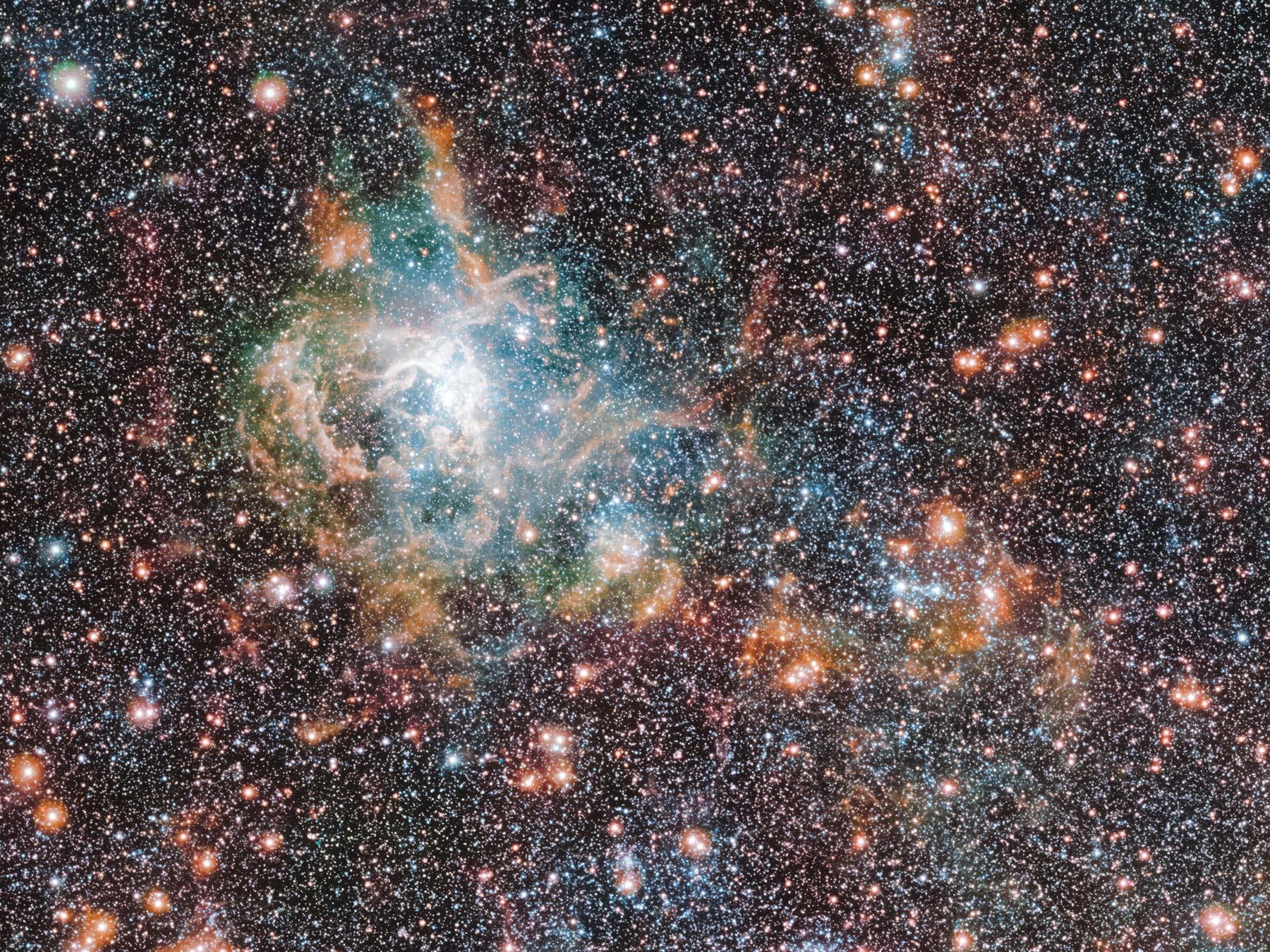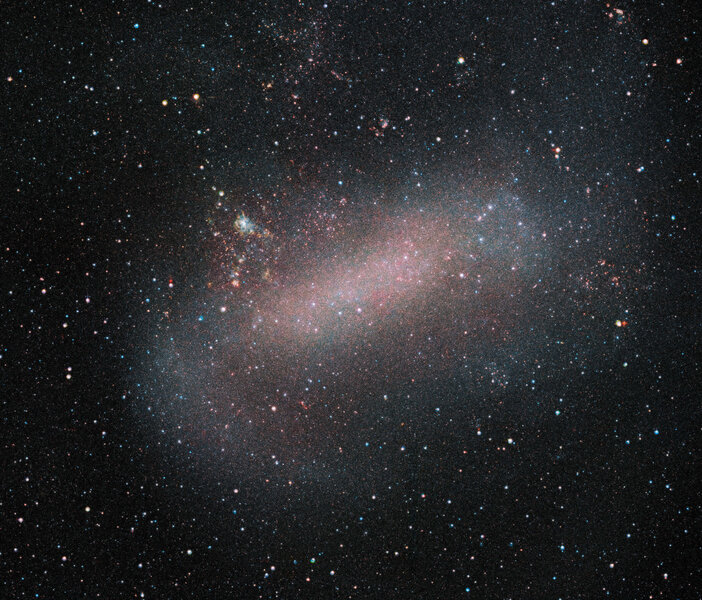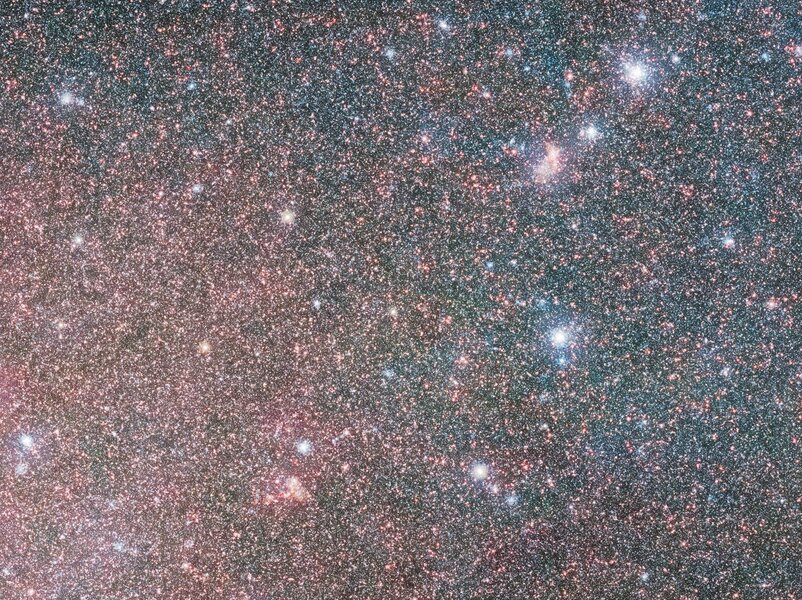Create a free profile to get unlimited access to exclusive videos, sweepstakes, and more!
Reassessing an irregular spiral: A spectacular image of the Large Magellanic Cloud

Two of the things I truly love about astronomy are that a) it changes rapidly sometimes, with new discoveries happening all the time, and 2) these force me to rethink things I thought I knew, and do a little mental housecleaning every now and again.
For example: Our Milky Way galaxy is an immense flat disk with spiral arms. Since long before I was born, astronomers have understood that these arms are very common in disk galaxies, and can't be due to the galaxy physically winding up like string on a spool. If that were the case, then the arms would eventually pull themselves apart. To counter this they came up with the idea that spirals are density waves, like traffic jams in space. This is what we've thought for decades, and been teaching students all this time.
However, a recent result is that in fact the arms might actually be physical structures after all! I wrote an article detailing all that, and it's really interesting, so I suggest you go read that.
But that's not why I'm writing today. That's a subtle argument dealing with spiral patterns and star motions and all that. What I want to show you today is something a lot more obvious… once you know how to look.
The Milky Way is not alone in space; several dozen dwarf galaxies orbit it (possibly many more), including two that are much larger than the rest. They are called the Small and Large Magellanic Clouds (or SMC and LMC); both are visible from the southern hemisphere as fuzzy patches in the sky, but they are both galaxies in their own right.
For most of my life, I've "known" that the LMC is an irregular galaxy, one without an overall shape to it. Then, more recently, it's been thought to in fact have a shape: A single arm sweeping around with a thick rectangular bar across the middle (and is actually the prototype for a kind of galaxy called a "Magellanic spiral"). OK, in images I can kinda see that, and it does change how I think about it. But it never really sank in.
And then, ye gads, I saw this, and boom. It all became clear:
Yes! Look at that! You can see the thick bar right through the middle, and the arc of the spiral arm very obvious to the lower left, and an arc more subtly to the upper right. Clear as day. [Note: I shrank this image down substantially to fit here. There's a staggeringly larger 480 Mb 28,638 × 31,985 pixel version, too, because wow.]
So why has it taken this long for me to really come around? Well, because I hadn't seen it quite this way: This image was taken using the European Southern Observatory's truly phenomenal VISTA (Visible and Infrared Survey Telescope for Astronomy), a 4-meter telescope with a wide field of view. It was able to take this image of the LMC in infrared, where these structures are a lot more obvious than in visible light. In visible, the galaxy is strewn with hydrogen gas, distracting from the overall shape. In the infrared the stars dominate (though some nebulosity can be seen, like the ridiculously showy Tarantula Nebula to the upper left).
In this image, what you see as blue is actually IR light at 1.02 microns, a wavelength about 50% longer than the human eye can see (we're good out to about 0.75 microns). Green is 1.25 microns, and red is 2.15 microns.
Not only does this make the structure obvious, but you can see two different populations of stars; the bar is "red", while the arm is "bluer." This image was taken in fact to look at the different colors of stars, and use them to trace their ages and populations. The astronomers involved looked at 10 million stars in the LMC (and 2.5 in the SMC) in the infrared, piercing through the dust and gas to see the stars themselves better.
They found that main sequence stars — stars like the Sun that are stably fusing hydrogen into helium in their cores — trace out the multiple (!) spiral arms seen, and that these stars have a median age of just 740 million years. That's young! But all the gas seen in visible light images makes it pretty clear the LMC is cranking out stars, even now. So the young age is no surprise.
What did surprise me is that supergiant stars, which are perforce young (really massive stars go through their fuel far, far faster than lower mass stars like the Sun, and only live a few million years) are concentrated in the bar. I expected they'd be in the spirals, which in galaxies like the Milky Way are where the vast majority of stars are born. They also found other effects that are more subtle, but these, to me, are the big surprises.
Well! Color me shocked (in visible and infrared colors). No sarcasm there; I'm serious. I had no idea this dwarf galaxy was so full of structure, and not just structure but stratified stellar populations, too. I thought it was just a morphological mess, punctuated by great splotchy gas clouds. But hidden away in there is all this wonderful organization, hidden in plain sight.
Now, I'm no expert in the LMC (despite having studied a small part of it for my PhD that had nothing to do with its overall structure), so perhaps to astronomers who have devoted their careers to it this comes as no surprise. But it does to me, and I cherish this feeling. Not the ignorance I had before, though that comes with no embarrassment. I simply had never been exposed to this.
And of course ignorance is curable, if one desires it. Even better, the cure is just so wonderful. More knowledge! More understanding! Better understanding! And a new appreciation for an object I perhaps hadn't given enough consideration to. That's a mistake I will try not to make again.
And if I do, at least I know that once again I get to have the truly wondrous experience of learning a new thing, and seeing an old thing in a new way. That's just the best.

















